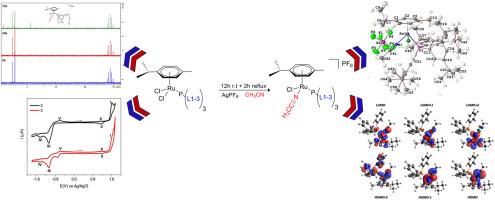Synthesis, characterization and investigation of the antibacterial activity of cationic complexes of Ru(II)-p-cymene phosphine with weakly-coordinating acetonitrile ligands
IF 2.1
3区 化学
Q3 CHEMISTRY, INORGANIC & NUCLEAR
引用次数: 0
Abstract
The synthesis and characterization of ruthenium(II)-arene triarylphosphine complexes, [Ru(η6-p-cymene)(PAr3)(NCCH3)Cl][PF6], where Ar = (3,5-tBu2C6H3-) (L1), (3,5-Me2C6H3-) (L2), (4-MeO-3,5-Me2C6H2-) (L3) and (4-MeOC6H4-) (L4), are described. The structures have been confirmed by IR and 31P NMR spectroscopy and by single crystal X ray diffraction studies. The redox behavior of the complexes has been investigated by voltammetry in CH3CN, with stability over a wide potential window ΔE ≅ 2.7 V. The antibacterial properties of the complexes have been studied against a Gram-positive and a Gram-negative strain. Complex 2 exhibits strong activity against S. aureus (MIC 25 µmol L-1, IC50 13.5 µmol L-1) and notably potent activity against MRSA (MIC 12.5 µmol L-1, IC50 8.52 µmol L-1). Complex 3 also demonstrates activity against S. aureus (MIC 25 µmol L-1, IC50 15.9 µmol L-1) and MRSA (IC50 11.04 µmol L-1), though its MIC against MRSA is >100 µmol L-1. By contrast, complex 4 is inactive. The interactions of 2 and 4 with phospholipid monolayers were investigated by the Langmuir monolayer method, in a system that simulates the Staphylococcus aureus cell membrane. Complex 2 interacts with and disrupts the organization of these monolayers, and this result possibly indicates that cell membrane rupture causes the antibacterial effect.

弱配位乙腈配体Ru(II)-对花香烃膦阳离子配合物的合成、表征及抗菌活性研究
本文描述了钌(II)-芳烃三芳基膦配合物[Ru(η - 6-p-cymene)(PAr3)(NCCH3)Cl][PF6]的合成和表征,其中Ar = (3,5- me2c6h3 -) (L1), (3,5- me2c6h3 -) (L2), (4- meo -3,5- me2c6h2 -) (L3)和(4-MeOC6H4-) (L4)。通过红外光谱、核磁共振31P谱和单晶X射线衍射研究证实了其结构。用伏安法研究了配合物在CH3CN中的氧化还原行为,在宽电位窗口ΔE = 2.7 V内具有稳定性。研究了该配合物对革兰氏阳性和革兰氏阴性菌株的抑菌性能。复合物2对金黄色葡萄球菌具有较强的抑制活性(MIC为25µmol L-1, IC50为13.5µmol L-1),对MRSA具有较强的抑制活性(MIC为12.5µmol L-1, IC50为8.52µmol L-1)。复合物3对金黄色葡萄球菌(MIC为25µmol L-1, IC50为15.9µmol L-1)和MRSA (IC50为11.04µmol L-1)也显示出活性,尽管其对MRSA的MIC为100µmol L-1。相反,复合体4是无活性的。在模拟金黄色葡萄球菌细胞膜的系统中,采用Langmuir单层法研究了2和4与磷脂单层的相互作用。配合物2与这些单分子层相互作用并破坏其组织,这一结果可能表明细胞膜破裂导致抗菌作用。
本文章由计算机程序翻译,如有差异,请以英文原文为准。
求助全文
约1分钟内获得全文
求助全文
来源期刊

Journal of Organometallic Chemistry
化学-无机化学与核化学
CiteScore
4.40
自引率
8.70%
发文量
221
审稿时长
36 days
期刊介绍:
The Journal of Organometallic Chemistry targets original papers dealing with theoretical aspects, structural chemistry, synthesis, physical and chemical properties (including reaction mechanisms), and practical applications of organometallic compounds.
Organometallic compounds are defined as compounds that contain metal - carbon bonds. The term metal includes all alkali and alkaline earth metals, all transition metals and the lanthanides and actinides in the Periodic Table. Metalloids including the elements in Group 13 and the heavier members of the Groups 14 - 16 are also included. The term chemistry includes syntheses, characterizations and reaction chemistry of all such compounds. Research reports based on use of organometallic complexes in bioorganometallic chemistry, medicine, material sciences, homogeneous catalysis and energy conversion are also welcome.
The scope of the journal has been enlarged to encompass important research on organometallic complexes in bioorganometallic chemistry and material sciences, and of heavier main group elements in organometallic chemistry. The journal also publishes review articles, short communications and notes.
 求助内容:
求助内容: 应助结果提醒方式:
应助结果提醒方式:


